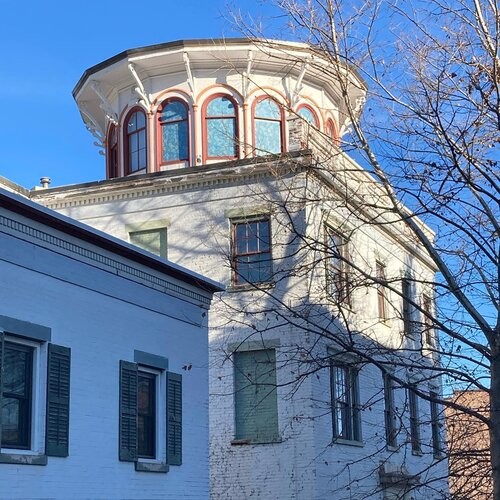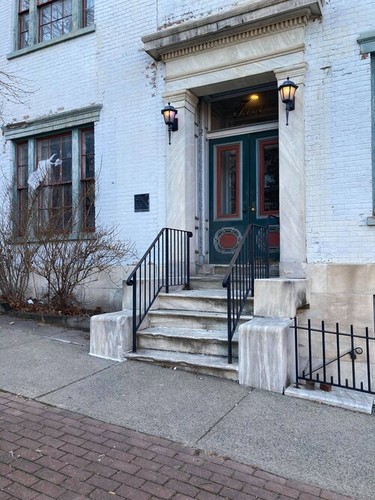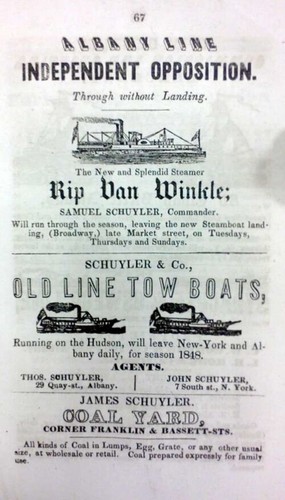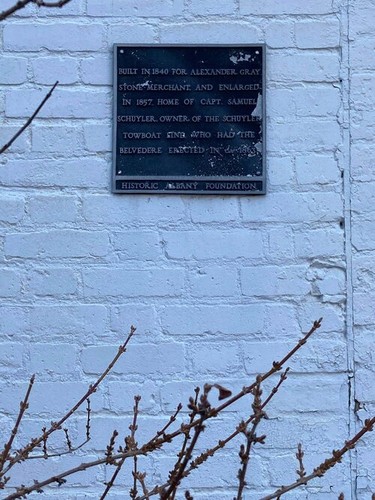2 Ash Grove Place
Introduction
Author-Uploaded Audio
Listen to a narration of this entry's description by Kim Parker .
Text-to-speech Audio
In the Mansion Historic District in the South End of Albany, there stands the impressive 2 Ash Grove Place. It was originally constructed in 1839 by Alexander Gray and his son William, two stonemasons and owners of a nearby stone yard. These gentlemen also built the houses at the next stop of our tour. From 1848 to 1894, this was the residence of Samuel Schuyler, one of the city’s wealthiest and most prominent African American businessmen. It was subsequently enlarged during his residency in 1857. In 1863, there was the addition of the recognizable belvedere at the top of the building. After taking on various uses, today, this building is a private condominium.
2 Ash Grove Place is one of the more elaborately decorated stops on this tour. Its recessed entrance encased in the larger decorative enframement, simple lintels and sills, and use of transoms is all evidence of the Greek Revival style of architecture. This building was added to the State and National Register of Historic Places in 1982 when the entire Mansion Historic District was listed.
Images
Iconic belvedere on 2 Ash Grove Pl

2 Ash Grove Pl: note the entranceway

Front entrance

Looking east towards 12-2 Ash Grove Pl, January 1981



Towboat America by James Bard

Backstory and Context
Author-Uploaded Audio
Listen to a narration of this entry's description by Kim Parker .
Text-to-speech Audio
Some of the streets in the Mansion Historic District date back to the eighteenth century, including Trinity Place which was created in 1836. Ash Grove Place was not named until 1869 due to the fact that it was originally the continuation of Westerlo Street. It was renamed after the Ashgrove Methodist Church, constructed in 1863-1865. This church was located at the southwest corner of Ash Grove and Trinity. When the nomination for the district was being completed in the 1980s, that same southwest corner was occupied by the Philip Schuyler High School. The building has since then been converted to the Schuyler Apartments. The Mansion neighborhood illustrates the transitional period in American architecture during the nineteenth century, as there are Federal, Greek Revival, and Italianate style structures throughout.
2 Ashgrove Place itself was built in 1839 by stonemasons Alexander Gray and his son William. The rowhouses at 39-45 Trinity Place, adjacent to the home, were built by the Grays at the same time. From 1848 to 1894, 2 Ashgrove Place was home to one Samuel Schuyler., a very successful African-American businessman and philanthropist. Schuyler was the owner of the Samuel Schuyler & Company, later renamed Schuyler Tow Boat Line. Samuel Schuyler was named after his father (1781-1842), a successful riverboat captain. It has been speculated that the elder Samuel had been enslaved by the white Schuyler family, the relatives of founding father Alexander Hamilton. The Hudson River Maritime Museum writes, “Albany County manumission records report that a slave named Sam purchased his freedom in 1804 for $200 from Derek Schuyler. It is possible, but by no means certain, that Sam is the same man later referred to as Captain Samuel Schuyler '' (Exploring the History of the Black Hudson River Schuylers). The elder Samuel started the riverboat business that was eventually passed down to his sons (Samuel and Thomas).
The younger Samuel attended the old Beverwyck School in Albany. By the age of 12, he began his apprenticeship aboard the ship Sarah Jane. Eventually, he became the master of the ships the Favorite and the Rip Van Winkle, which he later purchased. Once he and his brother, Thomas (1811-1866) were running the family business, they acquired the Anna Marie and the Favorite and the steamboats Belle and The America. Samuel and Thomas married Margaret M. Bradford (1816-1881) and Ellen Bradford (1820-1900) respectively while running their business.
The brothers began to acquire steamboats in the 1840s. James Bard, renowned marine artist, made it a subject of a piece that now resides at the Albany Institute of History and Art. Around this time Samuel became the company’s president and Thomas became the treasurer. They expanded their trading endeavours to include grain and coal, and began to issue stock and invest in railroading. The business became critical to the operation of steam tows on the Hudson River. By 1888 they reportedly utilized eighteen ships for towing canal boats.
Both Samuel and Thomas were active in Albany business and charitable circles. Samuel, in addition to being the president of the company, also held positions as president of the First National Bank and director in the Commerce Insurance Company.
Schuyler enlarged his home at 2 Ash Grove Place westward in 1857 and added the belvedere in 1863. Samuel passed away in 1894 and was buried in the Albany Rural Cemetery. After Samuel’s death, 2 Ashgrove Place went through a number of changes of use. First, it became the South End Medical Dispensary, soon after becaming the first open-air school for tuberculosis in 1904, jointly run by the city’s Anti-Tuberculosis Committee and the Board of Education. Today it is a private condominium.
The iconic Italianate belvedere on 2 Ash Grove place is a wonderful feature of the building, as are the more ornate Greek Revival characteristics. It has an iconic pilastered, recessed entrance encased by one of the most decorative entablatures you will see on this tour. There are simple sills and lintels, as well as a denticulated cornice and a wide frieze band. Fortunately, unlike other stops on the tour, it still has the 6/6 sash windows in place. The builders also added three-part windows, a typical window detail on Greek Revival homes, to the left of the main door. Although the belvedere is not open to the public, we are very curious about the view from up there!
Sources
Bender, Matthew. Albany Architecture: A Guide to the City. Edited by Diana S. Waite. Albany: Mount Ida Press, 1993. https://books.google.com/books?id=B_M7vlQPa8kC&printsec=frontcover&source=gbs_atb#v=onepage&q&f=false.
New York SP Mansion Historic District, 9/1/1982 [National Register for Historic Places Inventory - Nomination Form]; Records of the National Park Service, 1785-2006, Record Group 79; National Archives at College Park, College Park, MD [online version available through the Archival Research Catalog (ARC identifier 75316269) at https://catalog.archives.gov/id/75316269; February 25, 2021].
New York State Historic Preservation Office. 2 Ash Grove Pl, Albany NY. CRIS Entry 00140.002715.
"#WhereinAlbany - 2 Ashgrove Place." Historic Albany Foundation. January 29, 2021. Accessed February 25, 2021. https://www.historic-albany.org/news/category/%23WhereinAlbany.
Smith, Tashae and Mark Peckham. "Exploring the History of the Black Hudson River Schuylers." Hudson River Maritime Museum. January 1, 2019. https://www.hrmm.org/history-blog/category/captain-samuel-schuyler?fbclid=IwAR2BetFZ4R8VnpyitWgHsw2-DoBTr3ucC_18Ue89zrzS6f0lg4wWXBG2HV0.
https://www.historic-albany.org/news/2021/1/28/whereinalbany-2-ashgrove-place.
https://www.historic-albany.org/news/2021/1/28/whereinalbany-2-ashgrove-place.
https://www.historic-albany.org/news/2021/1/28/whereinalbany-2-ashgrove-place.
https://catalog.archives.gov/id/75316269
https://www.albany.edu/arce/Schuyler26.html
https://www.historic-albany.org/news/2021/1/28/whereinalbany-2-ashgrove-place.
https://www.flickr.com/photos/rexstewartoriginals/6853585818
